Pioneering women in aviation have significantly transformed the industry by breaking barriers and inspiring future generations. This article explores their notable contributions, the challenges they faced, and their enduring historical significance. Key figures such as Amelia Earhart and Bessie Coleman exemplify resilience in overcoming societal obstacles. Additionally, we will discuss the cultural context of women’s roles in aviation and practical strategies for aspiring female aviators.

What are the key contributions of pioneering women in aviation?
Pioneering women in aviation made significant contributions that transformed the industry. They broke barriers, inspired future generations, and advanced aviation technology and safety.
Amelia Earhart is renowned for her transatlantic flight, promoting women’s roles in aviation. Bessie Coleman was the first African American woman to earn a pilot’s license, overcoming racial and gender challenges. Harriet Quimby became the first woman to obtain a pilot’s license in the U.S. and was a vocal advocate for aviation safety.
These women faced societal obstacles but paved the way for future aviators. Their legacies continue to influence the aviation field today, showcasing the importance of diversity and inclusion.
How did Amelia Earhart influence the perception of women in aviation?
Amelia Earhart significantly changed the perception of women in aviation by demonstrating their capabilities and challenging societal norms. Her achievements inspired future generations of female aviators and highlighted women’s potential in traditionally male-dominated fields. Earhart’s solo transatlantic flight in 1932 established her as a role model, showcasing the unique attribute of her pioneering spirit. This accomplishment encouraged women to pursue careers in aviation, contributing to a gradual shift in public perception and acceptance of women as skilled pilots. Her legacy continues to empower women in aviation today.
What role did Bessie Coleman play in breaking racial barriers in aviation?
Bessie Coleman played a pivotal role in breaking racial barriers in aviation by becoming the first African American woman to earn a pilot’s license. Her achievements inspired many and highlighted the potential for diversity in aviation. Coleman faced significant challenges, including racial and gender discrimination, yet she persevered, demonstrating resilience and determination. She used her platform to advocate for racial equality and encouraged other women and people of colour to pursue careers in aviation, making her a trailblazer in the field.
Which organizations were founded by women to support female aviators?
Organizations founded by women to support female aviators include the Ninety-Nines, established in 1929, and Women in Aviation International, founded in 1990. These organizations aim to promote women in aviation and provide networking opportunities. The Ninety-Nines specifically focuses on mentoring and scholarships for female pilots. Women in Aviation International offers resources for career development and advocacy for women in the industry. Both organizations have significantly contributed to the advancement of women in aviation.
How have women contributed to advancements in aviation technology?
Women have significantly advanced aviation technology through innovation, leadership, and advocacy. Pioneers like Amelia Earhart and Bessie Coleman broke barriers, inspiring future generations. Their contributions include developing flight training programs and promoting women’s roles in aviation. Additionally, modern figures like Eileen Collins and Patty Wagstaff continue to push technological boundaries in aerospace. These women faced challenges such as gender discrimination and limited opportunities, yet their perseverance has shaped the industry. Their historical significance is evident in the increased representation of women in aviation roles today, fostering a more inclusive environment.
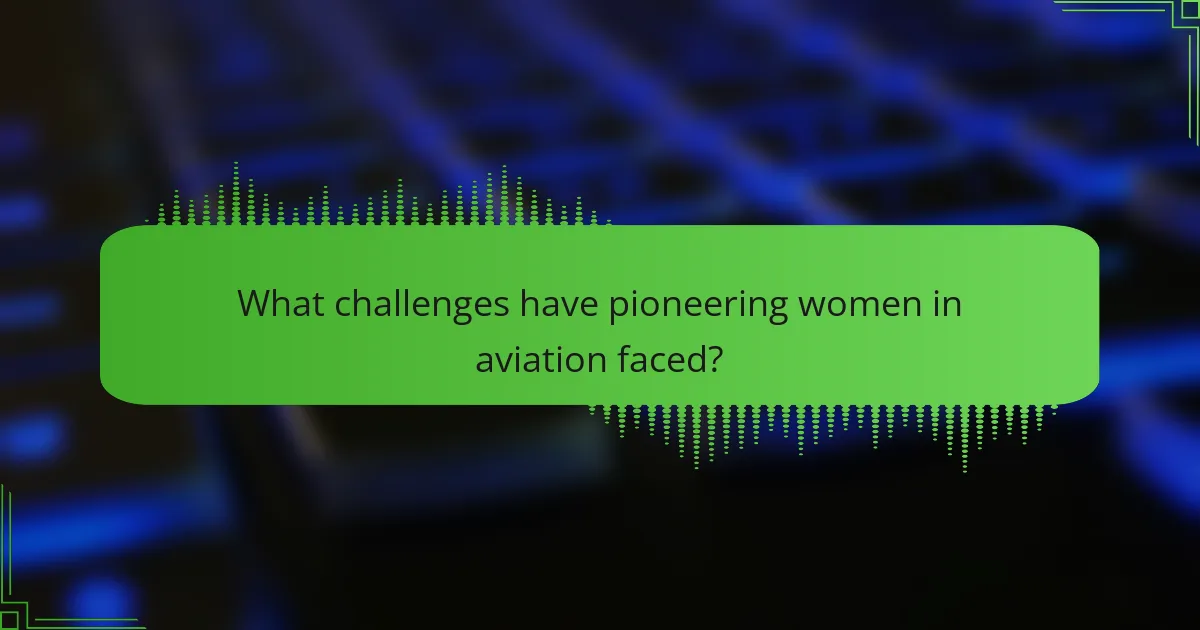
What challenges have pioneering women in aviation faced?
Pioneering women in aviation have faced significant challenges, including societal discrimination, limited access to training, and lack of funding. These barriers often hindered their ability to gain recognition and opportunities. For example, Amelia Earhart struggled against gender stereotypes while advocating for women in aviation. Additionally, many women had to navigate a male-dominated industry that often undervalued their contributions. Despite these obstacles, their resilience paved the way for future generations, highlighting their historical significance in reshaping aviation.
How did societal norms impact women’s participation in aviation historically?
Societal norms historically limited women’s participation in aviation through restrictive gender roles. These norms often portrayed women as unsuitable for technical and leadership positions. As a result, female aviators faced significant challenges, including lack of support, funding, and recognition. Pioneering figures like Amelia Earhart and Bessie Coleman broke these barriers, demonstrating that women could excel in aviation. Their contributions reshaped perceptions and laid the groundwork for future generations, highlighting the importance of challenging societal norms in achieving equality in aviation.
What obstacles did women aviators encounter in gaining recognition?
Women aviators faced significant obstacles in gaining recognition, including societal biases, limited access to training, and a lack of support from aviation institutions. Many women struggled against stereotypes that portrayed flying as a male domain. Additionally, funding and sponsorship opportunities were often unavailable, hindering their ability to pursue aviation careers. Despite these challenges, women like Amelia Earhart and Bessie Coleman made remarkable contributions, breaking barriers and paving the way for future generations.
How have women navigated gender bias in aviation careers?
Women have navigated gender bias in aviation through resilience, advocacy, and groundbreaking achievements. Pioneers like Amelia Earhart and Bessie Coleman challenged societal norms and opened doors for future generations. Despite facing discrimination, women in aviation have consistently advocated for equality, resulting in increased representation in leadership roles. Historical milestones, such as the formation of the Ninety-Nines, a women pilots’ organization, highlight their collective efforts to combat bias and support one another. Today, organizations continue to promote diversity and inclusion, fostering an environment where women can thrive in aviation careers.
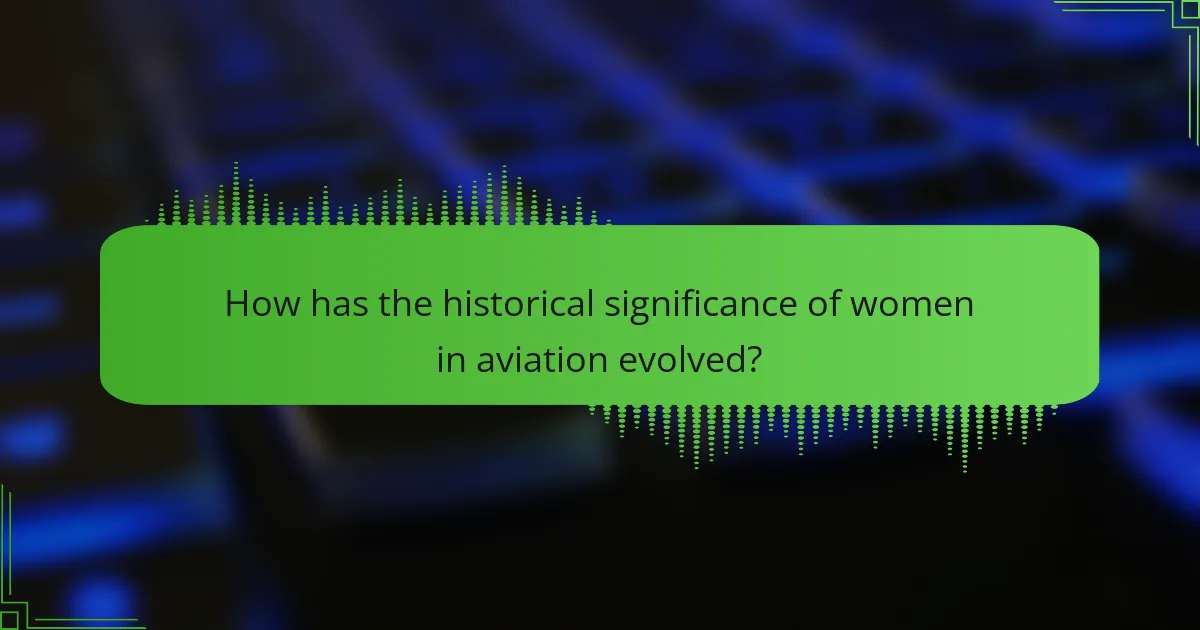
How has the historical significance of women in aviation evolved?
The historical significance of women in aviation has evolved from pioneering efforts to widespread recognition. Women like Amelia Earhart and Bessie Coleman broke barriers, inspiring future generations. Their contributions faced societal challenges, yet they paved the way for women in modern aviation roles. Today, women hold leadership positions in aerospace, reflecting a significant cultural shift. The unique attribute of resilience in overcoming obstacles has become a hallmark of women’s impact in this field.
What milestones mark the progress of women in aviation over the decades?
Milestones in women’s aviation include Amelia Earhart’s solo transatlantic flight in 1932, the establishment of the Ninety-Nines organization in 1929, and the first female military pilots during World War II. In 1973, women were allowed to fly combat missions, marking a significant shift. The first female space pilot, Eileen Collins, commanded a Space Shuttle in 1999, showcasing women’s advancements in aviation. These milestones reflect the ongoing contributions and challenges faced by women in the field.
How have women’s achievements in aviation been commemorated?
Women’s achievements in aviation have been commemorated through various initiatives, including memorials, awards, and educational programs. Notable examples include the establishment of International Women in Aviation Day and the Women in Aviation International organization, which honour female pioneers. Museums often feature exhibits dedicated to women aviators, showcasing their contributions to the field. Additionally, biographies and documentaries highlight their stories, ensuring their legacies are recognized and celebrated.
What impact have pioneering women had on contemporary aviation culture?
Pioneering women have significantly shaped contemporary aviation culture through their groundbreaking achievements and advocacy for gender equality. Figures like Amelia Earhart and Bessie Coleman broke barriers, inspiring future generations to pursue aviation careers. Their contributions fostered a more inclusive environment, challenging societal norms and encouraging women in aerospace fields. As a result, the representation of women in aviation has increased, leading to diverse perspectives and innovations in the industry.
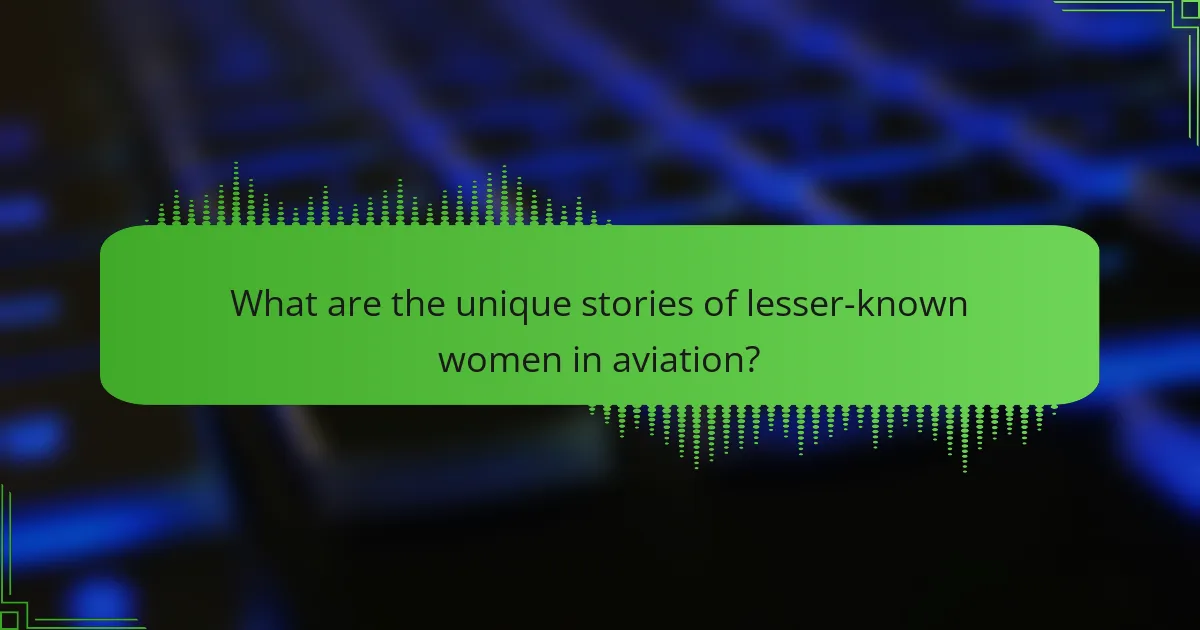
What are the unique stories of lesser-known women in aviation?
Lesser-known women in aviation have made significant contributions despite facing considerable challenges. For instance, Bessie Coleman became the first African American woman to earn a pilot’s license in 1921, overcoming racial barriers. Amelia Earhart, while famous, inspired many women to pursue aviation, but less recognized figures like Harriet Quimby, the first woman to earn a pilot’s license in the U.S. in 1911, paved the way for future generations. Additionally, women like Jacqueline Cochran, who set numerous speed records and was the first woman to fly a bomber across the Atlantic, showcased women’s capabilities in a male-dominated field. Their stories highlight resilience and the historical significance of women’s roles in aviation.
Which women made significant contributions during World War II?
Many women made significant contributions during World War II, particularly in aviation. Notable figures include Amelia Earhart, who inspired female pilots, and the Women Airforce Service Pilots (WASP), who flew military aircraft. These pioneers faced challenges such as societal skepticism and limited resources but ultimately paved the way for future generations in aviation. Their historical significance lies in breaking gender barriers and demonstrating women’s capabilities in traditionally male-dominated fields.
What are the stories of women aviators from different regions?
Women aviators from various regions have made significant contributions to aviation history, overcoming numerous challenges. In North America, Amelia Earhart became a symbol of courage and determination, famously being the first woman to fly solo across the Atlantic Ocean. In Europe, Bessie Coleman broke barriers as the first African American woman to hold a pilot’s license, inspiring many with her achievements despite facing racial and gender discrimination.
In Asia, Harriot Quimby became the first woman to earn a pilot’s license in the United States and flew in the early 1900s, paving the way for future female pilots. In Australia, Nancy Bird Walton emerged as a pioneering aviator, establishing a successful career in commercial aviation during the 1930s.
These stories highlight the unique challenges faced by women in aviation, including societal expectations and limited opportunities. Their perseverance has not only shaped the aviation industry but also inspired generations of women to pursue careers in aviation and beyond.
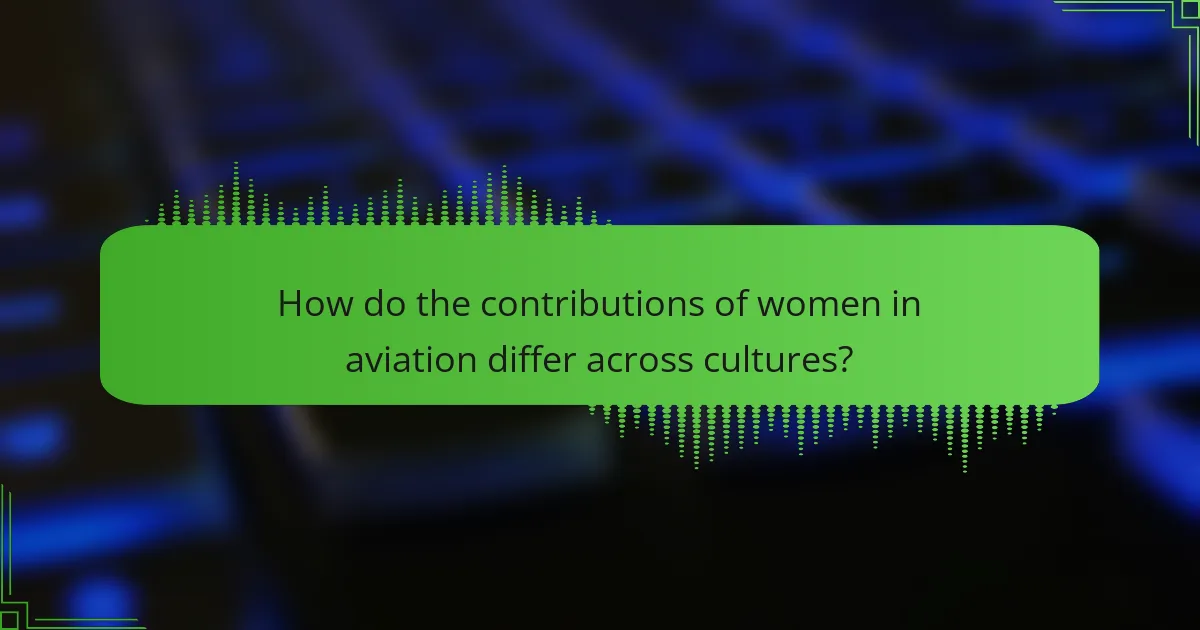
How do the contributions of women in aviation differ across cultures?
The contributions of women in aviation vary significantly across cultures due to differing societal norms and values. In some cultures, women have historically faced barriers to entry in aviation, while others have celebrated their achievements. For example, in Western countries, women like Amelia Earhart and Bessie Coleman broke through gender barriers, inspiring future generations. Conversely, in certain regions, cultural restrictions limit women’s roles in aviation, impacting their visibility and contributions. Additionally, countries with progressive gender policies often see higher participation rates among women in aviation, showcasing the influence of cultural context on their achievements.
What are the challenges faced by women aviators in various countries?
Women aviators face numerous challenges globally, including gender bias, limited opportunities, and safety concerns. In many countries, societal norms discourage women from pursuing aviation careers. For example, in regions with traditional gender roles, women often encounter resistance from family and community. Additionally, the aviation industry has historically been male-dominated, leading to fewer mentorship opportunities for women. Safety regulations and access to training can also vary significantly by country, impacting women’s ability to gain necessary experience. As a result, the journey for women in aviation remains fraught with obstacles, yet their contributions continue to pave the way for future generations.
How do cultural perceptions of women in aviation vary globally?
Cultural perceptions of women in aviation vary significantly across the globe. In some regions, women are celebrated as pioneers, while in others, they face societal barriers.
For instance, in the United States and Western Europe, women’s contributions to aviation, like those of Amelia Earhart, are widely recognized and celebrated. These cultures often promote gender equality, encouraging women to pursue careers in aviation.
Conversely, in parts of Asia and the Middle East, traditional gender roles can hinder women’s participation in aviation. In these areas, cultural norms may prioritize family responsibilities over professional aspirations, leading to fewer women in the field.
Overall, while progress is being made, the challenges women face in aviation are deeply influenced by cultural attitudes and societal expectations.
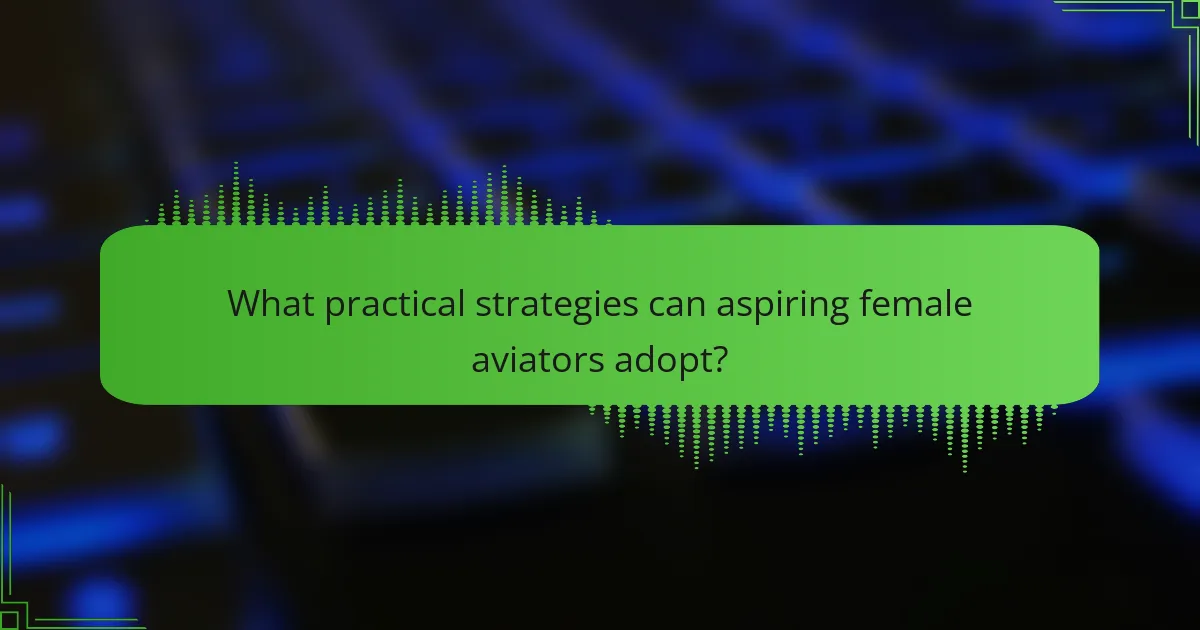
What practical strategies can aspiring female aviators adopt?
Aspiring female aviators can adopt several practical strategies to succeed in the aviation field. First, seek mentorship from experienced women in aviation to gain insights and guidance. Second, pursue relevant education and training, focusing on flight schools and programs that support women. Third, build a strong network by attending aviation events and joining organizations dedicated to women in aviation. Fourth, stay informed about industry trends and technological advancements to remain competitive. Finally, cultivate resilience and confidence to overcome challenges in a traditionally male-dominated field.
What mentorship opportunities exist for women entering aviation?
Numerous mentorship opportunities exist for women entering aviation, including formal programs, informal networks, and industry-specific initiatives. Organizations like Women in Aviation International and the Ninety-Nines offer mentorship programs connecting aspiring aviators with experienced professionals. Additionally, aviation schools often have mentorship arrangements to guide female students through their training. These opportunities foster skills development and enhance career prospects in a traditionally male-dominated field.
How can women overcome barriers to pursue aviation careers?
Women can overcome barriers to pursue aviation careers through mentorship, education, and networking. Access to role models inspires confidence and ambition. Educational programs tailored for women in aviation enhance skills and knowledge. Networking opportunities foster connections, leading to job placements and career advancement. Additionally, advocating for policy changes within the industry can create a more inclusive environment. By addressing these areas, women can effectively navigate challenges and thrive in aviation careers.
What resources are available for women interested in aviation education?
Numerous resources support women pursuing aviation education. Organizations like Women in Aviation International offer scholarships, mentorship, and networking opportunities. The Ninety-Nines, an international organization of women pilots, provides resources and advocacy. Flight schools and universities often have specific programs aimed at encouraging female students. Additionally, online platforms offer courses and webinars tailored for women in aviation.


